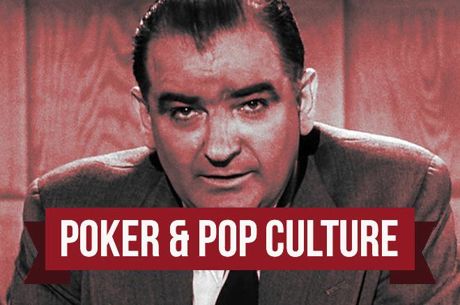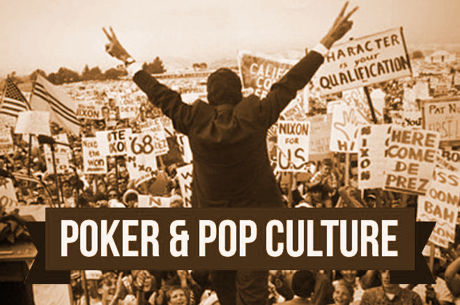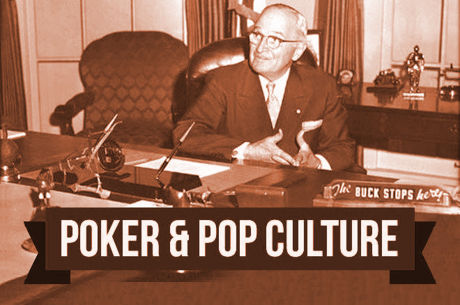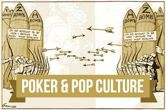Poker & Pop Culture: Catching Up with Cards at the Newsstand

Those of us who spend most of our time at the poker tables always find it curious whenever we look up from our cards long enough to notice some "mainstream" reporting about our favorite game.
Probably the most conspicuous recent examples were articles about the "Brains vs. AI" match that concluded at the end of January. Reports on the 20-day no-limit hold'em match in which Carnegie Mellon University's artificial intelligence computer program Libratus beat a team of pros appeared in a wide variety of publications, including Time, The Washington Post, The Chicago Tribune, The Guardian, Wired and a host of other newspapers and magazines.
We've had occasion already in this series to share items appearing in mainstream newspapers and magazines — articles that have helped fill in particulars regarding certain figures or events in poker's history while also further proving poker's popularity among the culture at large.
For example, "The Long, Strange Life of the Dead Man's Hand" included details from a relatively famous 1867 profile of James Butler "Wild Bill" Hickok appearing in Harper's New Monthly Magazine that greatly built up (and embellished) the card-playing gunslinger's status as an Old West hero. A similarly exaggerated profile of another 19th-century card player appearing in an 1881 issue of The New York Sun that provided one of "The Many Versions of Bat Masterson."
Meanwhile "Following Draw, 'Stud-Horse Poker' Gallops In" described the introduction and early history of stud poker, having occasion to quote from an 1884 article opinion piece appearing in The New York Times in which the San Francisco Chief of Police offered dire warnings about "the magnitude of the evil which has resulted" from the spread of stud. More recently when discussing an early Humphrey Bogart film in "Play by the Book or Risk a 'Dead End,'" an article appearing in The Chicago Tribune argued that the film's inclusion of a poker scene "may be very beneficial for the game" thanks to the way it taught a mini-lesson about starting hand selection in five-card draw.
A Defense of Stud Poker
For anyone scouting for information regarding the early history of five- and seven-card stud, an article appearing in the September 1, 1934 issue of The Reading Eagle provides an interesting "mainstream" glimpse of the status of that variant's popularity.
There amid the pages of the Pennsylvania-based daily paper appeared a review of George Henry Fisher's important early strategy text, Stud Poker Blue Book, the first edition of which had appeared in 1931. The review was written by Westbrook Pegler of The Chicago Tribune as another installment of his regular, syndicated column "Fair Enough," and finds the writer praising the book while also complaining in a tongue-in-cheek way about stud poker being overtaken by bridge as the game of choice among card players.
"For some reason bridge has claimed rating as the gentleman's game and is considered to be desirable nowadays as a part of the social equipment of young officers of the army, along with dancing, tennis and the etiquette of the seven-fork formal dinner," writes a derisive-sounding Pegler.
Pegler has hope, though, in the contemporary example of then-vice president John Nance Garner — a.k.a. "Cactus Jack" — who like the president, Franklin Delano Roosevelt, was known to be an avid poker player. In fact, Pegler calls Garner "one of the great American experts in stud," giving Pegler reason to make the humorous recommendation that Garner "help to install Mr. Fisher's Stud Poker Blue Book as one of the official studies at West Point."
A Fictional Story Sharing a Poker Truth
Those picking up a copy of the April 14, 1945 issue of The New Yorker would encounter a poker-themed short story by Robert McLaughlin titled "Let's Get Rid of the Ribbon Clerks" that helps underscore the centrality of poker to military life — a topic we've addressed here before more than once in articles about Civil War poker and poker being played during the first World War. McLaughlin's story additionally provides a less time-bound warning to poker player's regarding the dangers of playing "over your head."
While stationed in Florida a lieutenant named Fred Wilson eagerly joins a poker game at the Officers' Club, one featuring "a couple of brass hats from Washington sitting in" and higher stakes than he normally plays. To play in the game requires a well-placed fib to his wife and the borrowing of extra cash so as to have enough to play. Alas for Wilson, the cards go against him, and he ends up borrowing more during the game. Then in desperation he incorrectly calls off nearly everything he has after incorrectly guessing an opponent holding a straight to have been bluffing.
Forced to leave the game, Lt. Wilson suffers the ignominy of overhearing the others discuss how much he'd dropped and joking about whether or not his checks to them would bounce. "Men who can't afford it shouldn't play poker," says one just before Wilson is out of earshot.
There are multiple lessons advanced, including a poker-specific one about going into battle unprepared, and a more general one having to do with fighting lost causes.
Poker in the Post
Probably the most famous poker-related article appearing in a non-poker publication during these middle decades of the 20th century was a piece titled "Winning at Poker" by Herbert O. Yardley featured in the November 9, 1957 issue of The Saturday Evening Post. The article was in fact a preview of sorts for a book by Yardley about to be published the following week titled The Education of a Poker Player.
Yardley was already a well known figure thanks to his prominent role in the early days of United States military intelligence. Yardley used his skills as a cryptographer to head MI-8, an intelligence unit established near the end of WWI that continued until its closure just after the stock market crash in 1929.
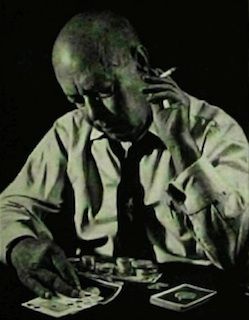
Yardley then wrote a bestselling memoir called The American Black Chamber describing the experience, earning him renown as an author and for his contributions to national security, but also condemnation from the U.S. government for his having revealed secrets previously unknown to numerous other countries.
Having ruined his career working for U.S. intelligence, Yardley did work for Canada and China while doing some occasional consulting in Hollywood. Meanwhile from his youth he also played poker, and right near the end of his life wrote The Education of a Poker Player, a book combining poker strategy advice for a variety of draw and stud games with autobiographical anecdotes (all poker related).
The Post article was advertised on the issue's front cover and provided a condensed adaptation of some of the early stories of Yardley's poker playing at "Monty's Place," a kind of amalgam of several real-life places where he'd first played the game as a teenager. Interspersed in the article were poker quizzes about five-card draw and five-card stud that also shared some of Yardley's advice, presenting hands and asking readers "How Would You Play Them?"
It was kind of unusual to have genuine, hardcore poker strategy appear amid the otherwise family-oriented Post whose articles and stories tended to portray an America mirrored by the Norman Rockwell paintings often featured on the magazine's cover (including this issue). But it proved a good decision by the magazine, which according to Yardley biographer David Kahn sold a record-breaking 5.6 million copies of the issue thanks largely to a newly-developed hunger for such poker strategy advice.
California poker, circa 1967
Launched in 1954, Sports Illustrated often featured articles about poker amid its pages during its first few decades. One such article appears in the April 17, 1967 issue, a fascinating sketch of California poker rooms by Dick Miles.
Miles was a famous table tennis player, known worldwide as the top U.S. player around from the mid-1940s through the early 1960s. After his career he began writing about table tennis for SI. He also authored an important 1968 book The Game of Table Tennis that shared many of his winning techniques. Miles additional branched out to write features on other subjects for the magazine, and after visiting a half-dozen card rooms in Gardena shared a great study titled "Lowball in a Time Capsule."
Miles sketches typical player-dealt, low-stakes poker for the reader where characters like "Sitting Bull" hold court in the "three-and-six draw games," an elderly woman described as "tight as a coffin lid." Even Nick Dandalos makes a cameo, the famous "Nick the Greek" better known for having once played in a certain legendary high-stakes game with Johnny Moss during the early days of Binion's Horseshoe.
Miles provides lively descriptions the games and types of people they attracted, the use of props, and how cardrooms dealt with potential cheaters. He also gets across how "gambling seems only a partial motive" for the participants, with the camaraderie among what was then an older crowd (on average) also a big draw.
Miles additionally does a neat job conveying the strange frozen-in-time quality of the games that inspires his article's title. "The notion struck me that the inhabitants of the room had been shuffling, cutting and squeezing their cards not for 60 hours, or even for 60 years, but forever," Miles writes, "as though in some prehistoric age they had been quick-frozen and tucked into a time capsule until, thawed by the California sun, they resumed their play heedless of the interruption."
It's a fantastic piece, which along with David Hayano's 1982 book Poker Faces and the opening scene of the 1974 film California Split actually does function for us as a kind of "time capsule" preserving a moment in poker's history. The article is archived online here in the SI Vault, if you're curious.
Introducing a new poker variant, "Hold Me"
Finally I'll quickly share one other poker item from the newsstands, this one having some historical value for those looking for information about the early days of Texas hold'em.
Richard Nixon appears on the cover of the August 16, 1968 issue of LIFE, less than three months away from winning that year's presidential election. Nixon was a poker player, of course, although an article inside that issue about poker has nothing to do with "Tricky Dick."
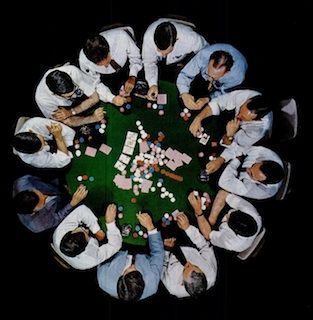
Rather, a four-page article titled "'Hold Me': a wild new poker game and how to tame it" by A.D. Livingston introduces LIFE readers to a newly popular poker variant, with Livingston explaining the rules and offering some beginner strategy advice.
As you might have guessed, the game Livingston calls "Hold Me" (short for "Hold Me Darling") is in fact hold'em, and Livingston — author of several books on poker — is enthusiastic about its prospects.
"Exactly how widely Hold Me has spread is hard to determine," writes Livingston. "The reports I've had indicate that it has covered the country, though many purely social groups may not have heard of it."
"A few weeks ago I called a poker man in Colorado and asked whether Hold Me Darling was being dealt out there," he continues. "'Never heard of it,' he said. 'But a new game has really caught on. High Hold 'Em. Each player gets two cards down. You bet on 'em. Then three cards are turned up in the middle...'"
Whatever the game was called then, it had caught on well enough to get featured in LIFE. You can read that one online, too, if you like, by clicking here.
From the forthcoming "Poker & Pop Culture: Telling the Story of America's Favorite Card Game." Martin Harris teaches a course in "Poker in American Film and Culture" in the American Studies program at UNC-Charlotte.

